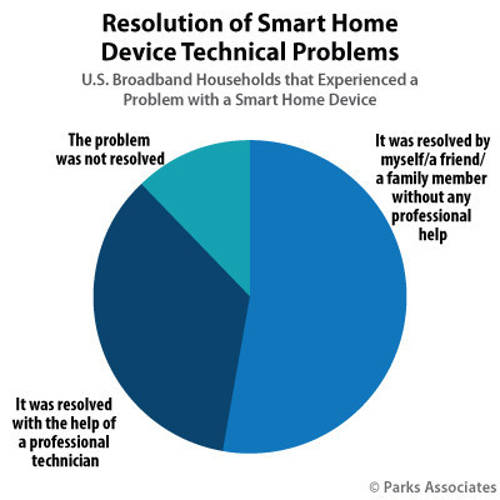In a solid sign that professional installation for the smart home is valuable, a new study from Parks Associates shows 12 percent of smart home device owners in U.S. broadband households report technical problems going unresolved in 2018.
That is compared to approximately 5 percent in the previous three years … a 240 percent increase in households with technical problems.
However, the data also reveals that the majority of consumers do not turn to a professional installer for assistance when there is a problem with their smart home devices. Instead, they opt to try to fix it on their own or ask a friend.
The data is from Parks new study entitled “360 View: Supporting the Connected Consumer,” which examines consumer appetite for self-help, professional, and premium support services, as well as consumer adoption of extended warranty services and the impact of adoption of smart home devices on support services.
“The number of reported problems declined, but the jump in unresolved problems points to issues getting more complicated and difficult to diagnose,” says Patrice Samuels, senior analyst, Parks Associates.
“Strong value is achieved from the smart home when devices communicate with each other, but diversity in device technology and communication protocols adds complexity to the smart home and creates challenges in achieving seamless communication.”
Many smart home devices require reliable Wi-Fi to operate, and for many home security and health devices, secure Wi-Fi is critical.
Connectivity Tops Troubles
Problems with connectivity are now the most persistent problems across all device types, so a support solution that can warn of potential or impending connectivity problems anywhere in a network and take steps to prevent outages will be valuable in the smart home ecosystem.
“The support experience reflects directly on a consumers' perception of that brand,” Samuels says.
“While most brands now recognize the need to adequately support their customers, minimizing the cost of doing so is critical to maintaining profitability. Knowledge about the devices consumers have in their homes helps boost the ability to anticipate challenges and invest in cost-efficient strategies to resolve them.”
Read Next: Sleep Trackers Offer Money Making Opportunity
Other data from the study reports:
- 79 percent of smart home device owners set up at least one device by themselves or with the help of friends and family.
- Only 16 percent of consumers who set up computing and entertainment devices themselves report that the process is difficult.
- Only 14 percent of smart home device owners report experiencing one or more problems with a device in 2018.
- 72 percent of consumers who paid one-time fees for support of smart home or computing/entertainment devices paid $50 or more for their service.







